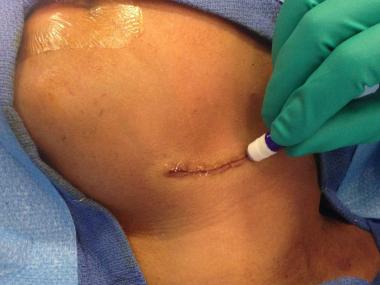Replacing Stitches with Super Glue By: John McCann, MD, PhD
- Posted on: Jul 15 2016
- one response
HISTORY
The earliest reports of sutures date back to 3000 BC in ancient Egypt, with suture material found in a mummy dating back to 1100 BC. Hippocrates wrote about the different techniques of suturing in 400 BC and by the 10th Century they were manufacturing absorbable gut sutures much like those used today.
MODERN SUTURES
Today we have access to all sorts of quality sterile suture materials on a plethora of needles. Most suture material used today is absorbable. Some is made of synthetic materials but eyelids are still commonly sutured with gut. These sutures are still manufactured from the purified collagen dervied from the guts of sheep.
SUTURES ARE AN ANCIENT BUT EFFECTIVE TECHNIQUE
The reason sutures have stayed a tool in the surgeon’s armamentarium for thousands of years is because they work. I cannot foresee a day during my career as a surgeon when I will completely quit using sutures. There are too many situations where there is not a better alternative.
SUTURE PROBLEMS
As versatile and effective as sutures are, and despite the fact that we have had thousands of years to come up with the perfect suture material, sutures still have flaws. For instance, the most common cause of an infection is an infection of a stitch. This occurs when the bacteria which normally live on your skin attach to a stitch causing a minor localized infection. This can slow down wound healing but resolves when the suture is removed. Non-absorbable sutures need to be removed which require an additional office visit and patients generally find suture removal unpleasant. Absorbable sutures do not require removal but sometimes absorb too slowly which can cause little bumps in the incision site, or worse yet, they can absorb too soon causing a wound to split open. Most of these problems are caused by the superficial sutures which are visible on the skin.
SUPERGLUE AS A SUPERFICIAL SUTURE SUBSTITUTE
Superglue spray was first used to close wounds in 1966 during the Vietnam War. A major cause of death was soldiers bleeding out on the battle field while waiting to be transferred to a medical facility. Superglue spray was used by medics on the battlefield to save soldiers lives.
A chemically modified version of superglue which is strong but less irritating to the skin was approved by the FDA in 1998. Dermabond is the form of medical glue most used by surgeons today. Liquid bandage is an over the counter form of modified superglue used to close small superficial cuts. Not only does superglue bind the skin together it also acts as a barrier to bacteria.
USE OF MEDICAL GLUE AT THE CENTER FOR FACIAL APPEARANCES
Studies have shown us that wounds generally heal best when deep absorbable sutures (not visible through the skin) are combined with superficial skin sutures. In many situations I still use deep absorbable sutures but I have replaced the superficial skin stitches with medical glue. The eyelid is too thin for deep sutures so I have combined absorbable skin sutures with glue. A benefit in both situations is that it is not necessary to remove the sutures which I find my patients appreciate, because the glue falls off just after the wound has healed. Not using skin stitches prevents nearly all stitch infections. Medical glue even acts as a barrier to bacteria, including bacteria that are resistant to antibiotics, making it unnecessary to use antibiotic ointment on the incision site. This saves our patients both time and money. The incision sites also seem to look better sooner when compared to the use of traditional skin stitches. Replacing many skin sutures with glue is another step along the way toward perfecting surgery.
Posted in: Uncategorized





Responses:
I adore this site – its so usefull and helpfull. http://bit.ly/2p7LTKb
Comment by 4rx on April 11, 2017 at 11:19 pm